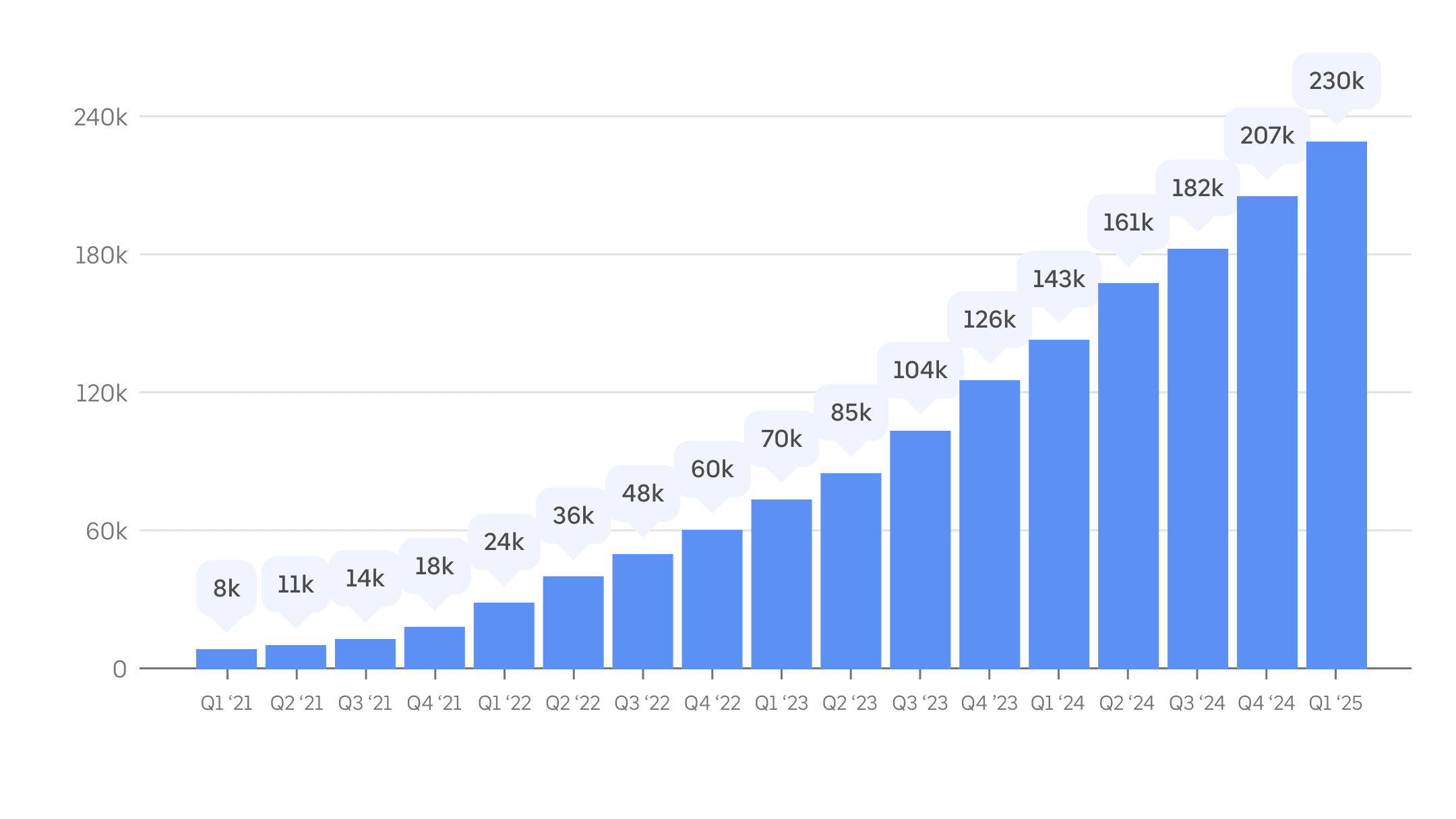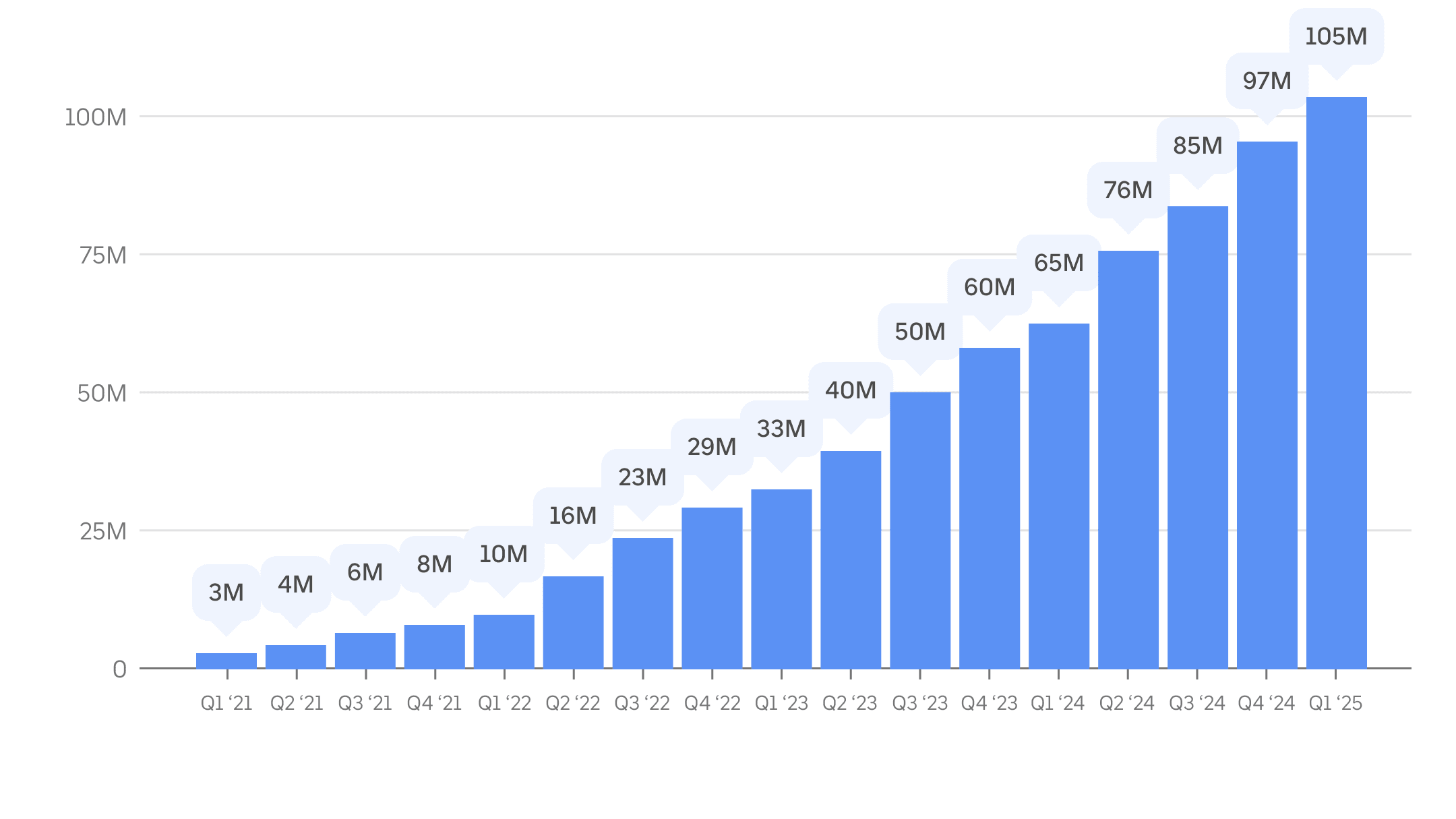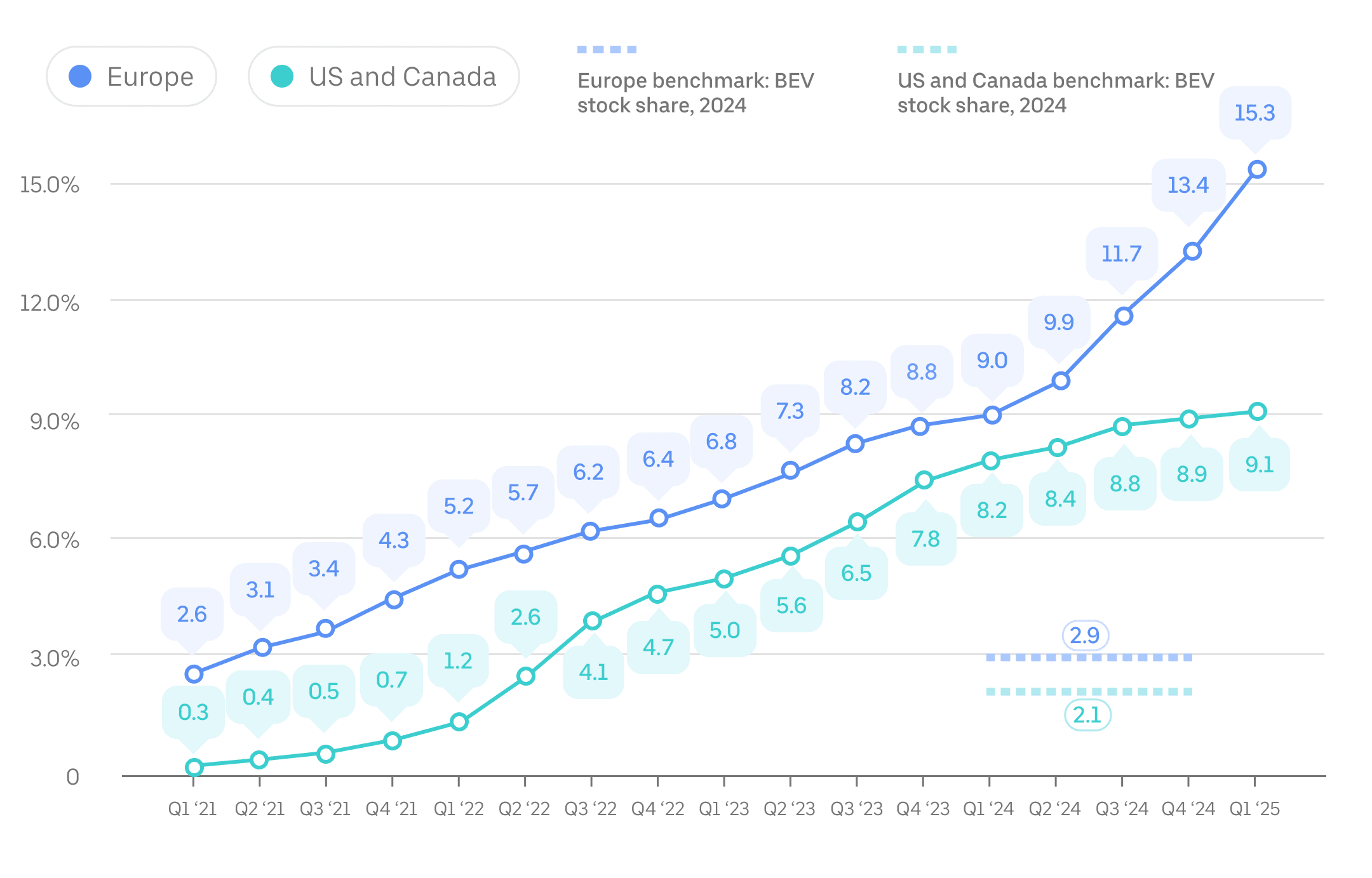Az Uber elektromos bővüléssel kapcsolatos naprakész információi
„Ambiciózus erőfeszítéseink, hogy átálljunk egy zéró kibocsátású mobilitási platformra jelentős előrelépést eredményeztek. Mára az Uber a világ legszélesebb körben hozzáférhető platformja, ahol zéró kibocsátású fuvarok érhetők el, és az Egyesült Államokban, Kanadában és Európában a sofőrök akár ötször gyorsabban térnek át elektromos járművek vezetésére, mint az átlagos autósok.”
Rebecca Tinucci, az Uber globális elektromos bővülési és fenntarthatósági vezetője
Naprakész információk 2025 első negyedévére vonatkozóan: Ez az oldal a belső égésű motoros (ICE) járművekkel és a zéró kibocsátású járművekkel (ZEV, például akkumulátoros elektromos járművek) az Uberen teljesített utazások mutatóit tartalmazza 2021 1. negyedévének elejétől 2025 1. negyedévének végéig. Fontos figyelembe venni, hogy a jelentés csak az Uber mobilitási üzletágára (fuvarmegosztásra) vonatkozik.
A zéró kibocsátás felé vezető utunk nyomon követése
Már öt éve tartanak ambiciózus erőfeszítéseink, hogy átálljunk egy zéró kibocsátású mobilitási platformra, és mostanra jelentős előrelépést tettünk. Mára az Uber a világ legszélesebb körben hozzáférhető platformja, ahol zéró kibocsátású fuvarok érhetők el, és az Egyesült Államokban, Kanadában és Európában a sofőrök akár ötször gyorsabban térnek át elektromos járművek (EV) vezetésére, mint az átlagos autósok.
Több százmillió dollárt fektettünk be, hogy ösztönzőkkel, partneri kapcsolatokkal és termékfejlesztésekkel segítsük az érdeklődő sofőröket az elektromos közlekedésre való átállásban – és ez kifizetődőnek bizonyult. Az utasok egyre gyakrabban vesznek igénybe először elektromos járművet az Uberen, ami világszerte elősegíti az elektromos közlekedés normalizálását és az átállás felgyorsítását.
Adataink azt mutatják, hogy az elektromos járművek fejlődése gyorsul, ha a kormány és az iparág együttműködik a megfelelő gazdasági körülmények kialakításában. Az olyan városokban, mint London, Vancouver és Amszterdam, ahol az átgondolt irányelvek, az iparági befektetések és az erős töltőhálózatok összehangoltan működnek, legalább minden 3., Uberrel megtett mérföld elektromos.
E jelentős előrelépés ellenére továbbra is markáns akadályok állnak a céljaink teljes mértékű elérése előtt. A magas előzetes elektromos költségek, a korlátozott hozzáférési lehetőségek és a nem következetes irányelvi támogatás továbbra is lassítja az átállást. A jelenlegi tendenciák alapján nem tudjuk teljesíteni a 2025-re hátralévő mobilitási és szállítási céljainkat, és a 2030-as céljainkat sem tudjuk elérni erősebb, összehangolt kormányzati és iparági fellépés nélkül.
Ahogy a kezdetektől fogva mondtuk: a klímaváltozási erőfeszítések csapatjátékot igényelnek, és a haladás a közös fellépésen múlik. Ezért egyre inkább előnyben részesítjük azokat az erőfeszítéseket, ahol az állami és a magánbefektetések összehangoltak.
Bár sok kulcsfontosságú tényezőre nincs ráhatásunk, továbbra is elkötelezettek vagyunk az átállás mellett – nemcsak azért, mert így helyes, hanem azért is, mert közvetlen és stratégiai üzleti előnyökkel is jár. Világszerte sofőrök ezrei vihetnek haza több pénzt az elektromos járművek alacsonyabb működési költségeinek és az utasok elektromos járművek iránti keresletének köszönhetően. Az utasok arról számoltak be, hogy elégedettebbek az elektromos járművekkel, ezért egyre gyakrabban választanak elektromos járműveket.
Végezetül: a jövő megosztott, elektromos és önvezető – és az önvezető (elektromos) járművek következő hulláma jelentős hátszelet teremt fenntarthatósági céljaink elérésében.
Az alábbi, legfrissebb naprakész információink felvázolják az eddigi eredményeket, a legfontosabb tudnivalókat és a 2025-ös és azt követő időszakra vonatkozó fókuszterületeinket.
__
Rebecca Tinucci, az Uber globális elektromos bővülési és fenntarthatósági vezetője
2025. május 7.
Nulla kibocsátású járművet vezető sofőrök
2025 első negyedévében világszerte több, mint 230 000 zéró kibocsátású sofőr használta az Uber alkalmazást. Ez több, mint 60%-kal több, mint egy évvel korábban.

Mutató: Aktív ZEV-sofőrök átlagos havi száma az Ubernél, negyedéves bontásban, 2021 első negyedéve óta. Az Uber alkalmazást használó sofőrök akkor számítanak aktívnak egy adott hónapban, ha abban a naptári hónapban teljesítettek legalább egy fuvart.
Nulla kibocsátású járművel teljesített fuvarok
2025 első negyedévében a ZEV-sofőrök világszerte több, mint 105 emissziómentes utat teljesítettek az Uberrel – több, mint 60%-kal többet, mint ahány ZEV-fuvart teljesítettek az Uberen egy évvel korábban. Ez átlagosan több, mint 13 ZEV-fuvart jelent az Uberen minden másodpercben.

Mutató: Az Uber alkalmazáson keresztül szervezett és a nulla kibocsátású járművet vezető sofőrök által teljesített fuvarok száma negyedévenként, 2021 1. negyedéve óta.
Nulla kibocsátású járművek elterjedése
2025 1. negyedévében Európában* az összes megtett kilométer 15,3%-át, az Egyesült Államokban és Kanadában pedig az összes megtett kilométer 9,1%-át teljesítették zéró kibocsátású járművet vezető sofőrök. Ezek az adaptációs értékek sokszorosan felülmúlják az átlagos járművezetőknél tapasztaltakat. A BloombergNEF 2024-es jelentésében közzétett adatok szerint az Uber sofőrjeinek körében a ZEV-ek elterjedése Európában körülbelül ötször gyorsabb volt, mint a hagyományos gépjárművezetők körében.
Az elmúlt 4 évben az Ubernél Európában, valamint az Egyesült Államokban és Kanadában átlagosan 3,1, valamint 2,2 százalékponttal nőtt a kizárólag elektromos hajtású járművekkel megtett távolság. Az ebben az időszakban tapasztalt legnagyobb és a legalacsonyabb éves növekedés is az elmúlt évben volt: 2024 első negyedéve óta a ZEV-használat Európában több, mint 6 százalékponttal, az Egyesült Államokban és Kanadában pedig alig 1 százalékponttal ugrott meg.

Mutató: Zéró kibocsátású járművekkel megtett fuvartávolságok aránya az Uber alkalmazásban szervezett teljes fuvartávolsághoz viszonyítva 2021 1. negyedéve óta, negyedévenként. A kanadai, az egyesült államokbeli és az európai referenciamutatók 2024-re vonatkoznak (ezek a jelen naprakész információk keletkezése idején elérhető legfrissebbek), és a Nemzetközi Energiaügynökségtől (IEA) származnak. A „BEV” rövidítés az akkumulátoros elektromos járműveket jelöli.
Utasok szén-dioxid-intenzitása
2024-ban az utasok Uberrel megtett egyes mérföldjei átlagosan 197 gramm CO2 (vagyis 123 gramm CO2/km) termelését eredményezték, az Egyesült Államokban és Kanadában pedig 340 gramm CO2 (vagyis 212 gramm CO2/kilométer) termelését. 2021-hez képest ez az utasok szén-dioxid-intenzitási mutatója Európában közel 14%-kal, az Egyesült Államokban és Kanadában pedig 6%-kal csökkent.
Az utasok szén-dioxid-intenzitása Európában, az Egyesült Államokban és Kanadában 2023 és 2024 között enyhén nőtt az átlagos utaskihasználtság kismértékű csökkenése és az „üres kilométerek” (az utasok felvétele előtt és az odafelé úton megtett távolság) számának növekedése miatt.
Mutató: Az utasok szén-dioxid-intenzitása, vagyis a megtett utasmérföldenkénti becsült CO₂ grammban kifejezve, az Uber által használt éves hatékonysági mutató – és egyre több kormány és a vállalat is használja világszerte. Fuvarmegosztás vagy bármilyen azonnali mobilitási szolgáltatás esetében az „üres” mérföldek által termelt kibocsátást figyelembe veszik a számításban.
Az utasok szén-dioxid-intenzitásának kiszámításával kapcsolatos részletek módszertani dokumentumunkban találhatók. Fontos figyelembe venni, hogy az Uber-járművekre Európában jellemző, az Egyesült Államokhoz és Kanadához képest jelentősen alacsonyabb mértékű üzemanyag-fogyasztás megmagyarázza a legtöbb, a szén-dioxid-intenzitásban jelentkező különbséget ezen két földrajzi terület között. Bár Európában a sofőrök által az Uber alkalmazáson keresztül használt járművek megoszlása hatékonyabb (mert magasabb arányban vannak jelen ZEV-k és hibridek), az Egyesült Államokban a szigorúbb üzemanyag-fogyasztási jelentési előírások is hozzájárulnak ehhez az eltéréshez. Emellett nem áll rendelkezésünkre elegendő adat az európai piacokon 2021 előtt teljesített utazásokról ahhoz, hogy az utasok szén-dioxid-intenzitását kiszámíthassuk.
Adatok és részletesebb elemzések
EVs for everyone: balanced adoption of a maturing technology (2024)
Hogy a fenntarthatóság legyen a jobb választás (2024)
How to help spark electric mobility across Europe (2024)
Kevesebb kibocsátás fenntartható útvonaltervezéssel (2023)
Miért más alapvetően az Uber, mint egy privát autó? (2021)
A mobilitás mérése a szén-dioxid-intenzitás szempontjából (2019)
Gyakori kérdések
- Mit tartalmaznak az Uber elektromos bővüléssel kapcsolatos naprakész információi?
Elektromos bővüléssel kapcsolatos naprakész információink az Uber alkalmazás által lehetővé tett személygépjármű-fuvarok szén-dioxid-kibocsátására és az elektromos bővülésre vonatkozó teljesítményalapú mérőszámokat bocsájtanak az érdekelt felek rendelkezésére.
- Miért teszi közzé a cég ezeket a naprakész információkat?
Ezek a naprakész információk, amelyek a mobilitási platformunk valós használatán alapulnak, segítenek nagyobb átláthatóságot biztosítani az elektromos bővülésre gyakorolt hatásunkról, és segítenek abban, hogy javítsuk a platformunk hatékonyságát.
- Melyek az elektromos bővüléssel kapcsolatos naprakész információk megszerzéséhez használt legfontosabb mérési adatok?
A mutatók többek közt a következők:
- A zéró kibocsátású járműveknek (ZEV) az Uber sofőrjei általi igénybevétele (a zéró kibocsátású járművel megtett mérföldek vagy kilométerek aránya), amely azt méri, hogyan halad az Uber, hogy 2040-ig elérje a 100%-ban zéró kibocsátású mobilitásra vonatkozó célját
- Utasok szén-dioxid-intenzitása, amely az utasok által megtett mérföldenkénti kibocsátást méri
- Hogyan segítik elő ezek a naprakész információk az Uber-fuvarok kibocsátásának csökkentését és az elektromos járművek szélesebb körű használatát?
Merész törekvésünk, hogy csökkentsük a fuvarok utasokra vonatkozó szén-dioxid-intenzitását, és növeljük a zéró kibocsátású járművek használatát az Uberen. Az előrehaladás mérése és átláthatósága fontos lépcsőfokok az út során.
- Az utasok inkább az Uberrel utaznak ahelyett, hogy alacsonyabb szén-dioxid-kibocsátású lehetőségeket vennének igénybe(pl. tömegközlekedés)?
Az Uber alkalmazással igénybe vehető fuvarok az utasok számára rendelkezésre álló számos közlekedési lehetőség egyikét jelentik. Az utazási módok választéka nagyban függ a különböző helyi piaci feltételektől. Az Amerikai Nemzeti Háztartásonkénti Utazási Felmérés (NHTS) adatai alapján folytatott elemzésünk azt mutatja, hogy a legfenntarthatóbb közlekedési módok (tömegközlekedés, séta és kerékpár) háztartásonkénti magasabb kihasználtsága korrelál a fuvarmegosztás és az egyéb azonnali megoldások magasabb kihasználtságával.
- Megméri a cég ugyanezeket az adatokat a világ többi országára vagy régiójára vonatkozóan is?
A fenti mutatók többsége így már globálisan lefedi az Uber alkalmazással teljesített összes utasfuvart. Elkötelezettek vagyunk amellett, hogy rendszeresen beszámoljunk az Uberrel megtett utakból származó szén-dioxid-kibocsátásról és egyéb hatásterületekről.
- Várhatóan milyen gyakorisággal fognak tájékoztatni az Uber elektromos bővüléssel kapcsolatos naprakész információiról?
A mérőszámokat legalább évente frissítjük; egyes mérőszámokat gyakrabban is frissíthetünk. Naptári évenként összesítve, évente közzétesszük a kibocsátási mérőszámokat (például az utasok szén-dioxid-intenzitását).
- Mit érthetünk „nulla kibocsátású jármű” alatt?
Ugyanúgy használjuk a „zéró kibocsátású jármű” (zero emission vehicle, ZEV) kifejezést, mint ahogy a Kaliforniai Levegőfelügyeleti Hatóság (Californian Air Resources Board, CARB) és az európai közlekedési és környezetvédelmi hatóságok (Transport &Environment, T&E): a kifejezés olyan járművekre vonatkozik, amelyek fedélzeti erőforrása nem bocsát ki közvetlenül CO2-t vagy más kritériumok szerint légszennyezőnek minősülő anyagot (például NOx, szálló por, CO₂ és SOx). A regionális eltéréseket az olvasó saját belátása szerint értelmezze.
Az Uber alkalmazását használó sofőrök manapság kétféle zéró kibocsátású járművel közlekednek: akkumulátoros elektromos járművekkel (akkumulátoros EV) és ritkán hidrogénhajtású üzemanyagcellás elektromos járművekkel (FCEV).
Természetesen a zéró kibocsátású jármű nevében a „zéró” kifejezés a jármű kipufogócsövéből származó zéró kibocsátást jelenti, nem pedig feltétlenül az összes kibocsátást, amely a gyártástól kezdve a jármű és energiaforrásának ártalmatlanításáig keletkezik. Mindezek figyelembevételével azonban független szakértők életciklus-elemzései azt mutatják, hogy „a ma nyilvántartásba vett átlagos, közepes méretű, akkumulátoros elektromos autók élettartamuk alatt Európában 66–69%-kal, az Egyesült Államokban 60%–68%-kal, Kínában 37%–45%-kal, Indiában pedig 19%–34%-kal kevesebb kibocsátást termelnek, mint a hasonló, benzinüzemű autók“.
- Mérni fogják a kiszállítási üzletmenetre gyakorolt hatást?
Naprakész információink az elektromos bővüléssel kapcsolatban jelenleg csak a mobilitási üzletágunk (fuvarmegosztás) elektromos bővüléssel és kibocsátással kapcsolatos mutatóira vonatkoznak. Arra törekszünk, hogy a jövőben figyelembe vegyük a kiszállítási kibocsátás és az elektromos bővülés terén elért eredményeinket is.
A csomagolás területén az Uber továbbra is befektet abba, hogy a kereskedők fenntartható megoldásokra álljanak át. Az elektromos bővüléshez hasonlóan azonban a haladás a közös fellépésen múlik. Előnyben részesítjük azokat az erőfeszítéseket, ahol az állami és a magánbefektetések összehangoltak. Franciaországban például a platformon nyújtott szolgáltatásoknál használt csomagolás több, mint 60%-a újrahasznosítható, újrafelhasználható vagy komposztálható, amit nemzeti előírások és helyi ösztönzők támogatnak.
Bár történt előrelépés, a jelenlegi tendenciák alapján nem tudjuk teljesíteni az összes 2025-ös célt, és a 2030-as céljainkat sem tudjuk elérni erősebb, összehangolt kormányzati és iparági fellépés nélkül.
Bár sok kulcsfontosságú tényezőre nincs ráhatásunk, továbbra is elkötelezettek vagyunk az átállás mellett. Ha többet szeretnél megtudni az Uber fenntarthatóbb csomagolásra vonatkozó, a kereskedőkkel együtt vallott szemléletéről, tekintsd meg az Uber Eats kereskedőknek weboldalt.
- Közli az Uber az 1., 2. és 3. hatókörű kibocsátásokat, és ha igen, hol találhatók ezek?
Az Uber bejelenti a CDP-nek az 1., 2. és 3. hatókörű kibocsátásokat. A legfrissebb pontszámunkat a CDP nyilvános vállalatipontszám-keresőjében találja. Ezen kibocsátási becslések tekintetében korlátozott biztosítékot adott egy független harmadik fél.
Ez az oldal és a kapcsolódó információk, naprakész információk, jelentések és weboldalak (a továbbiakban: „jelentés”) a jövőbeni üzleti céljainkkal és várakozásainkkal kapcsolatos megállapításokat tartalmaznak, illetve kitérnek a kockázatokra és a bizonytalanságokra is. A tényleges eredmények lényegesen eltérhetnek a várttól. Ez a jelentés továbbá csak tájékoztató jellegű, és nem képezheti üzleti vagy járművásárlási döntések alapját. Ne hagyatkozzon túlzottan a jövőre vonatkozó kijelentésekre. Nem vállaljuk ezen információk naprakészen tartását, kivéve, ha ezt jogszabály írja elő. Az Uber stratégiájáról további információt az Invest.uber.com oldalon talál.
A jelentésben közölt bizonyos adatok tekintetében az LRQA korlátozott biztosítékot adott. A kerekítési módszerek miatt előfordulhat, hogy az adatok eltérést mutatnak.
A jelentésben szereplő olyan kifejezések, mint a „sofőrök”, „futárok”, „kereset”, „zéró kibocsátású jármű” és „fenntartható csomagolás” használata általános jellegű, és követi az Uber Technologies, Inc. általi általános használat eseteinek mintáját. A szavak regionális eltéréseit az olvasó saját belátása szerint értelmezze.
A kibocsátás-ellensúlyozás Uber általi használatának áttekintése itt található meg.
Rólunk